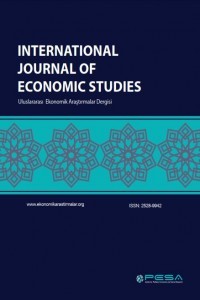Exploring the Use of Balanced Scorecards in a Transport Public Administration in Albania
Exploring the Use of Balanced Scorecards in a Transport Public Administration in Albania
Current account deficit intermediate goods, energy imports,
___
- Anthony, R. N. and V. Govindarajan (2001). Management control systems. Boston,McGraw- Hill.
- Arvidsson, M. (2003). Robust Design Experimentation and Dispersion Effects. Department of Quality Sciences. Göteborg, Chalmers University of Technology: 40.
- Axelsson, J. and B. Bergman (1999). Att bygga och riva pyramider - offensivkvalitets- och arbetsutveckling. Ständig förbättring - om utveckling av arbete ochkvalitet. T. Nilsson. Solna, Arbetslivsinstitutet: 31-96.
- Beer, M. and N. Nohria (2000). Resolving the Tension between Theories E and O of Change. Breaking the Code of Change. M. Beer and N. Nohria. Boston, Harvard Business School Press.
- Carlsson, J. (2000). Logistiskt Förändringsarbete - olika ansatser för operativ utveckling. Department of Management and Economics. Linköping, Linköping University: 107.
- Dahlgaard, J. J. and S. M. P. Dahlgaard (2002). TQM Measurements - A Metrology for Improvement and Change. IAQ Quality Improvement Handbook. US, International Academy for Quality and ASQ Quality Press.
- Dahlgaard, J. J., K. Kristensen and G. K. Kanji (1998). Fundamentals of Total Quality Management. London, Chapman & Hall.
- Deming, W. E. (1986). Out of the Crisis - Quality, Productivity and Competitive position. Cambridge, Cambridge University Press.
- Deming, W. E. (1993). The New Economics for Industry, Government and Edcucation. Massachusetts, MIT Center for Advanced Engineering Study.
- Drucker, P. F. (1955). The Practice of Management. London, The Heinemann Group.Linköping, Linköpings universitet: 196.
- Ekros, J.-P. (2000). Quality in Software Development - Methods for Fault Prediction and Cause Analysis. Division of Quality Technology and Management. Linköping, Linköpings universitet: 96.
- Guba, E. G. and Y. S. Lincoln (1994). Competing Paradigms in Qualitative Research. Handbook of Qualitative Research. N. K. Denzin and Y. S. Lincoln. New York, Sage Publications: 105-117.
- Haanes, K. and B. Lowendahl (1997). The Unit of Activity: Towards an Alternative to the Theories of the Firm. Strategy, Structure and Style. H. Thomas, D. O'Neal and M. Ghertman. Chichester; New York, Wiley.
- Hutchins, E. (1995). Cognition in the Wild. Cambridge, Massachusetts, MIT Press.
- Juran, J. M. (1951). The Quality Control Handbook. New York, McGraw-Hill.
- Juran, J. M. (1964). Managerial Breakthrough: A New Concept of the Manager's Job. New York, McGraw-Hill.
- Juran, J. M. and F. M. Gryna (1980). Quality planning and analysis. New York
- Kammerlind, P. (2000). On the Use fo Design of Experiments in Systems Engineering.
- Kaplan, R. S. and D. P. Norton (1996b). The Balanced Scorecard: translating strategy into action. Boston, Harvard Business School Press.
- Kaplan, R. S. and D. P. Norton (2001). The Strategy-focused Organization. Boston, Harvard Business School Press.
- Keller, C. and J. D. Keller (1996). Thinking and acting with iron. Understanding practice - Perspectives on activity and context. J. Lave and S. Chaiklin. Cambridge, Cambridge University Press: 125-143.
- Marr, D. (1982). Vision: A Computational Investigation into the Human Representation and Processing of Visual Information. New York, Freeman.
- Olsson, J. (2002). Factors of Importance for Understanding Successful ImprovementInitiatives in Swedish Health Care. Department of Total Quality Management.Göteborg, Chalmers University of Technology: 98.
- Olve, N.-G., C.-J. Petri, J. Roy and S. Roy (2003). Making Scorecards Actionable. Stockholm, Wiley.
- Pettigrew, A. and R. Whipp (1991). Managing change for competitive success. Cambridge, Blackwell.
- ISSN: 2528-9942
- Başlangıç: 2015
- Yayıncı: Politik Ekonomik ve Sosyal Araştırmalar Merkezi
Exploring the Use of Balanced Scorecards in a Transport Public Administration in Albania
Çalışma Hayatı Kalitesinin Tanımlanmasına İlişkin Sorunlar: Türkiye İçin Bir Tanım Önerisi
Ekrem ERDOĞAN, Cihan DURMUŞKAYA
Cari Açık Problemi Çerçevesinde Türkiye’de Ara Mal ve Enerji İthalatı
Doğrudan AR-GE Etkisi ve Teknolojinin Difüzyonu: Türkiye Örneği
Özlem FİKİRLİ, Mustafa Emir YÜCEL
Jeffrey B. NUGENT, Mehmet DEMİRAL
Yeliz PEKERŞEN, Aynur GÜLENÇ BİRSEN, Nalan ASLAN
Social Capital Failure: Negative Externalities of Social Capital
A Study on The Determinants of Income in Turkey
